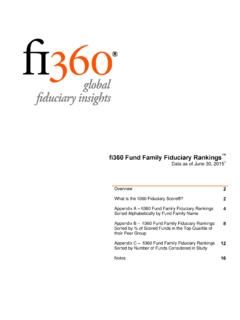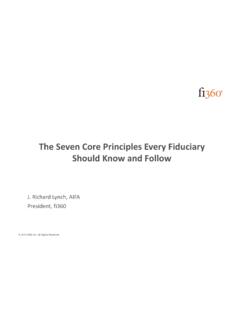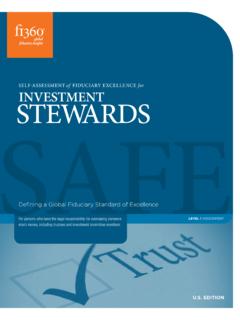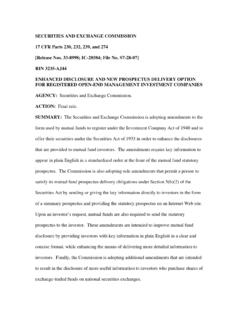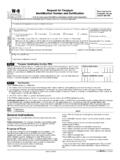Transcription of Definition of the Term ‘Fiduciary’ - Fi360
1 Executive Summary Definition of the Term fiduciary Department of Labor Conflict of Interest Rule 1 April 15, 2016 I. Introduction. Background. The Department of Labor (the Department or DOL ) on April 6, 2016, released the final rule (the Rule ) updating the Definition of a fiduciary under the Employee Retirement Income Security Act of 1974 ( ERISA ). The Rule is the culmination of six years of effort by the DOL to broaden the Definition of fiduciary advice to ERISA plans and extend it to include advice on individual accounts including IRAs. The debate over the rulemaking has been contentious and the subject of intense scrutiny. For the most part the Rule retains the basic framework of the 2015 proposal (the Proposal ) and responds to various comments by streamlining and clarifying parts of the rule and extending the overall compliance dates.
2 The original proposal was introduced in 2010 and withdrawn the following year in response to strong industry opposition and bipartisan concerns expressed in Congress. Following an unexpected hiatus of five years, the 2010 proposal was formally withdrawn with the introduction of the final proposal on April 14, 2015, which first introduced the new three part test of fiduciary advice, the extension of a fiduciary standard of care for individual accounts, and a number of prohibited transaction exemptions, most notably the Best Interest Contract Exemption ( BICE or BIC Exemption ). Fi360 s initial review of the final Rule concludes that the Rule does indeed retain the key components from the Proposal and reduces many of the requirements that industry opponents considered onerous.
3 However, the original purpose of the rulemaking, which was to update a four decades old rule and respond by aligning current market conduct standards for retirement advice with ERISA s longstanding fiduciary standard, has survived largely intact. According to an April 6, 2016, White House fact sheet the final 1 This executive summary is a regulatory overview and should not be relied upon as a legal authority or advice for compliance purposes. Although most of the material requirements are covered, readers are advised to review the rule for specific details, some of which are omitted in this condensed summary. 2 rule and related exemptions will ensure that retirement savers get investment advice in their best interest. II.
4 Overview. Consistent with the 2015 Proposal, the final Rule broadens the Definition of fiduciary for firms and financial advisors providing investment advice to ERISA plans and IRAs, and extends fiduciary coverage to rollover advice and distributions. The Rule also retains the BIC Exemption, the most controversial feature of the 2015 Proposal. The BIC Exemption is designed to allow brokers and their firms to receive commissions and other third party compensation while subject to regulatory constraints that preserve robust duties of loyalty and care under ERISA s prudence standard. New streamlining concessions of the exemption will ostensibly improve its utility with a phased in approach for compliance that begins April 10, 2017. Full compliance is required Jan. 1, 2018.
5 The original proposal anticipated eight months for compliance. One other new prohibited transaction exemption ( PTE ), the Principal Transactions Exemption, permits the sale of certain fixed income securities from a financial service firm s inventory in ERISA plans and IRA accounts. Up to 18 months would be permitted for full compliance by firms wishing to use the safe harbor, or Jan. 1, 2018. The PTE is somewhat similar to a safe harbor under the Investment Advisers Act of 1940 for dually registered broker dealers placing high grade bonds into advisory accounts. One of the most significant differences between the two laws is broker recommendations to plan participants and IRA accounts under the Rule would be subject to a much stronger prudence standard compared to the implied duty of suitability under the Investment Advisers Act of 1940 ( Advisers Act ).
6 The final Rule also retains other PTEs with modifications generally consistent with the 2015 Proposal. Among other things, exclusions from the fiduciary Definition attempt to distinguish between investment advice and education when an advisor or service provider is acting in a non fiduciary capacity. Status. In response to industry criticism and partisan congressional pressure to add more time to the implementation deadline, the Department has extended the eight month period under the Proposal to a much longer phased implementation in the final Rule. A. The revised Definition of a fiduciary takes effect April 10, 2017. B. The BIC and Principal Transaction exemptions go into partial effect on this same date. Firms relying on the safe harbors for these two PTEs have to comply with a limited set of conditions initially.
7 For the BIC Exemption, these limited conditions include acknowledging fiduciary status, adhering to a best interest standard, and making basic disclosures about conflicts. The remaining requirements under BICE 3 will go into full effect on Jan. 1, 2018, or approximately 18 months after the April 2016 date of publication. III. Definition of a fiduciary . Current. The four decades old five part test for determining functional fiduciary status under ERISA is defined as a person who does not have discretionary authority over plan assets and who, for compensation 1. Renders advice as to the value of securities or other property; 2. On a regular basis; 3. Pursuant to a mutual agreement; 4. The advice serves as the primary basis for investment decisions; and 5. The advice is individualized.
8 All five prongs of the test must be met to be deemed an investment fiduciary . New Definition . The proposed changes would essentially remove the regular and primary basis prongs (nos. 2 and 4) from the Definition and thereby expand the advisory activities and persons subject to the fiduciary Definition . For purposes of the ERISA sec. 3(21) and Internal Revenue Code sec. 4975 ( the Code ) Definition , a fiduciary is a person who, for compensation renders investment advice to a plan or IRA (including participants of a plan) through a recommendation as to 1. The advisability of investing in securities or other investment property, including advice on rollovers, transfer or distributions from a plan or IRA; and 2. The management of securities or other investment property, including recommendations on investment policies or strategies, portfolio composition, professional referrals for investing services, types of investment accounts (such as brokerage versus advisory) and rollover activities including the destination.
9 Holding Out. Persons who represent themselves as ERISA fiduciaries and who provide investment advice for compensation would be held to the fiduciary standard under ERISA. Communications. The final Rule relies in part, but not explicitly, on FINRA guidance to brokers describing when a communication, based on its context, content, and presentation, would be viewed as a recommendation, or fiduciary activity. Essentially the Department views investment advice as a call to action to pursue an investment strategy or purchase a product. Put another way, a communication is a recommendation when the advice recipient reasonably views the communication as a suggestion to either engage in or refrain from taking a particular course of action. 4 Scope of application. The Definition generally applies to investment advice provided to, among others, defined contribution plans, IRAs, health savings accounts ( HSAs ), certain 403(b) plans, Keoghs, Savings Incentive Match Plans for Employees ( SIMPLEs ), SIMPLE IRAs, and Simplified Employee Pensions ( SEPs ).
10 Duty to monitor. The rule states that the ongoing obligation to monitor is a function of the reasonable expectations, understandings, arrangements, or agreements of the parties. Whether a duty to monitor exists is determined in part by the scope of the agreement in place. However, the DOL makes clear that consideration should be given to whether an investment can be prudently recommended at all without a mechanism for ongoing monitoring. IV. Exemptions from the fiduciary Definition . Given the more expansive Definition of a fiduciary , the final Rule retains most of the carve outs from the 2015 Proposal. Subject to additional conditions, the carve outs would cover six activities of persons who do not provide advice and who do not represent themselves as ERISA fiduciaries. Note that the DOL has dropped the use of the term carve out in the final Rule to describe exemptions from the Definition .
